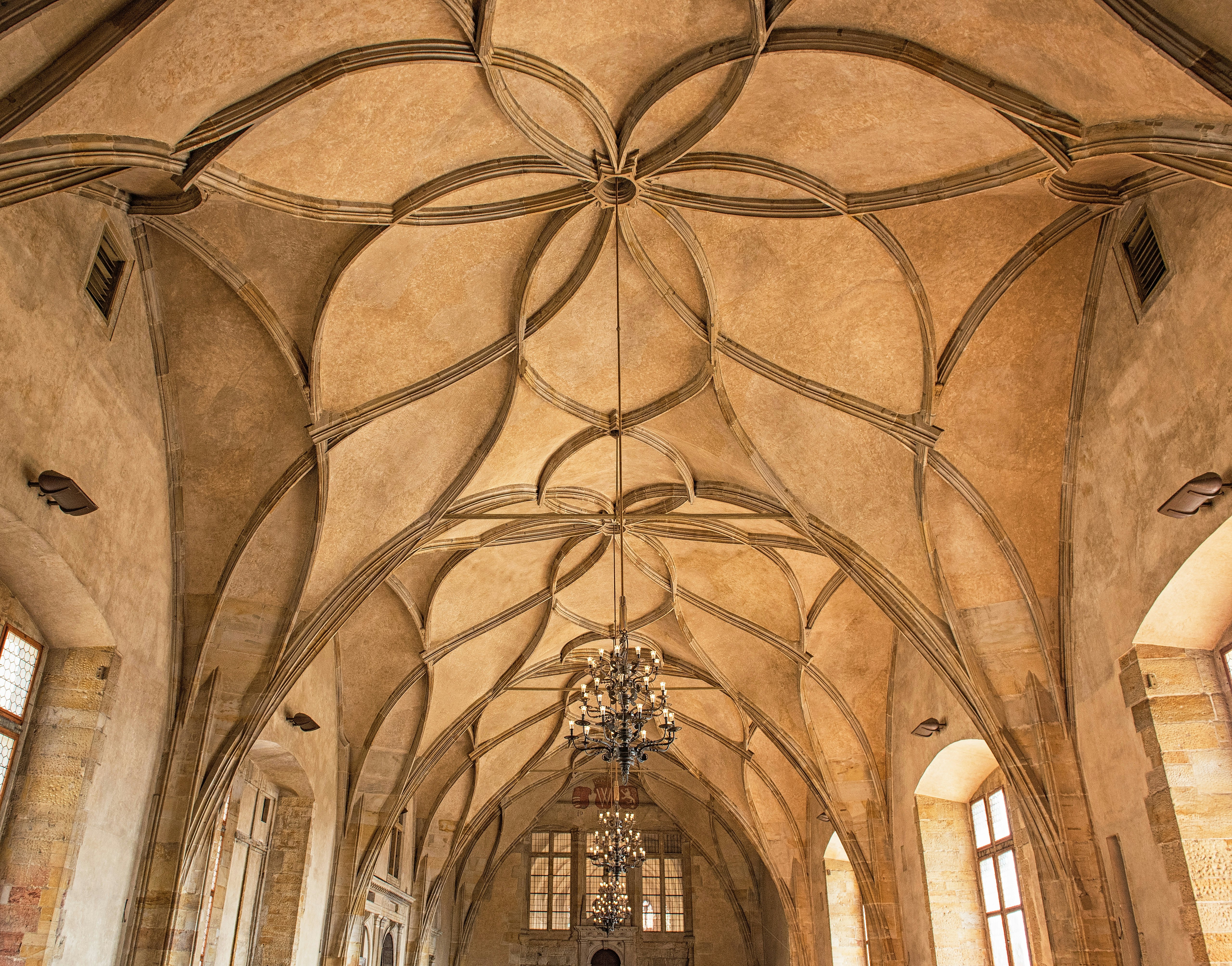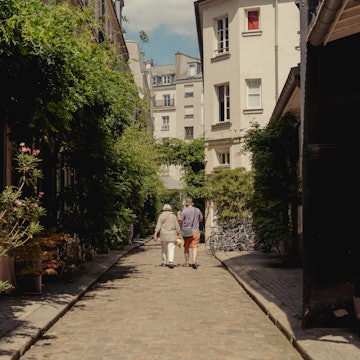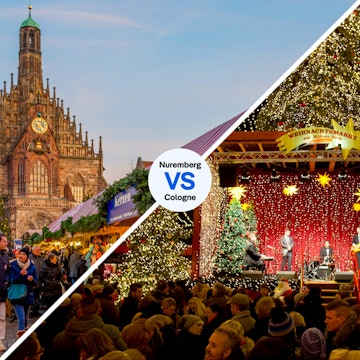
Best places in Prague to follow in the footsteps of Dan Brown's ‘Secret of Secrets’

Oct 16, 2025 • 10 min read

Wallenstein Garden in the Mala Strana district of Prague. Duncan Andison/Shutterstock
Dan Brown, who found world renown with his novel The Da Vinci Code, likes to think of the cities where he sets his novels as characters as much as his recurring protagonist, Robert Langdon. Paris got such treatment in The Da Vinci Code and Rome was featured heavily in Angels and Demons. Now it’s Prague’s turn to step into the spotlight: his latest book, The Secret of Secrets, takes place along its cobblestone lanes and in its medieval cellars, Cold War-era bomb shelters, stunning Baroque libraries, and towers overlooking the “City of 100 Spires.”
You could read the novel as a guide to Prague, following in Robert Langdon’s footsteps as he tries – as in Brown's five other Langdon-centered novels – to thwart a catastrophe involving a world-changing conspiracy from shadowy figures and organizations. Between the bomb explosions, the secret meetings, and the cryptic symbols we’ve come to know as a Dan Brown tome, the capital of the Czechia shines on the pages of The Secret of Secrets. Prague, Brown writes, is “a place of magical possibilities.”
If you’re in Prague and hoping to get caught up in a mystery and/or uncover a global conspiracy that could have earth-shattering consequences, here are some of the places Brown used as inspiration.
1. Black Angel’s Bar
Best for drinking enough cocktails to start believing in conspiracy theories
One of the characters in The Secret of Secrets makes a brief stop into Black Angel’s Bar, a subterrestrial cocktail den below the Hotel U Prince, near Old Town Square. Dan Brown himself loves this bar. When he finished writing the novel, he gathered some friends here and they helped the author partake in his regular ritual when he finishes a novel: imbibing the classic cocktail called The Last Word, a blend of gin, green chartreuse, maraschino liqueur and a pinch of lime. The bar has a new supplemental menu of Dan Brown-related cocktails.
In addition to this subterranean cocktail bar, other places to drink like Robert Langdon that were mentioned in the novel include Týnskà Literary Cafe, located down a passageway behind the bewitchingly Gothic Týn Church on Old Town Square, which Brown writes is for “writers and intellectuals”; AnonymouS Bar, a cocktail bar “for hackers and intrigue seekers,” where the bartenders wear Guy Fawkes masks while they make your drink; and Hemingway Bar, “for the sophisticated and cocktail connoisseurs.”
Planning tip: For Black Angel’s Bar and Hemingway Bar, it’s best to make a reservation via the bars’ websites.

2. The Baroque library at the Klementinum
Best for walking where Mozart, Einstein and Kepler walked
“The Klementinum – like so many of the stunning buildings in Europe – was erected to further the glory of the Christian God,” Brown writes at the start of Chapter 61. This vast complex on the Old Town side of Charles Bridge was the headquarters for the Jesuits, the Catholic order that was sent to Prague in 1556 by Holy Roman Emperor Ferdinand I to try to push back the Reformation zeal that had spread throughout much of Bohemia at the time.
Within the Klementinum is a Baroque library crammed with over 20,000 centuries-old books, mostly dedicated to astronomy and science. In the first few decades of the 17th century, astronomers Tycho Brahe and Johannes Kepler used the library as an office. Mozart performed in the Klementium several times in the 1780s, Albert Einstein taught physics in here In the second decade of the 20th century.
“This library was Langdon’s favorite room in Prague, and possibly in all of Europe,” writes Brown during a pivotal scene in the book in which Langdon is being hunted by the Czech secret police. “Even in Landon’s current state of distress, he still found the room utterly transfixing.” From the intricate Rococo ceiling murals to the antique globes on display, the library is a must see for anyone visiting the Czech capital.

3. Charles Bridge
Best for a morning stroll
Robert Langdon (and Dan Brown) knows one of the secrets to the Charles Bridge, the 14th-century stone span studded with Baroque-era statues of saints and Biblical figures: avoid the bridge except for very early in the morning or late at night when you’ll nearly have it to yourself. As Langdon was strolling across the snow-speckled bridge in the early morning, he thinks: “I’m alone on Charles Bridge … a life moment.” A paragraph or so after this, one of the book’s main inciting incidents occurs on the bridge.
Planning tip: If you don’t want to walk across the bridge and back again, take tram number 22 either from or to Malostranské Naměstí, which stops close to the bridge.

4. Church of Our Lady Victorious
Best for spying a holy ‘Barbie doll’
The Church of Our Lady Victorious in the neighborhood of Mala Strana, at the base of Petřin Hill, tends to blend in with the many other Baroque-era churches sprinkled around Prague. But there’s one reason to step inside, which is what Langdon and his girlfriend Katherine Solomon do: to see the Infant Jesus of Prague, a 19-inch wax doll of the baby Jesus that is said to have performed divine miracles. The doll is dressed in various costumes throughout the year. In The Secret of Secrets, Brown writes that the doll is “bizarrely fetishistic” and that it appears like “some kind of sacred Barbie doll.”
5. Folimanka Park
Best for getting out of the tourist-crammed center of town
This hilly, verdant area is south of the historical center, just outside the 14th-century walls that Emperor Chalres IV had erected. The park itself receives a few mentions in The Secret of Secrets, but it’s what is underneath that plays a big role in the book’s plot. For that you’ll have to descend into the Folimanka bomb shelter. Built during the Cold War, the underground lair can fit about 1300 people. It’s open for free tours (only in Czech) one day per month.
Planning tip: Double up on your sightseeing while visiting Folimanka Park and bomb shelter by taking a 20-minute stroll southeast for fabulous views of the city at Vyšehrad, a ruined hilltop castle site and cemetery.
6. Four Seasons Hotel
Best for indulging in luxury and style
Katherine Solomon is in Prague to give a lecture and persuades her boyfriend, Robert Langdon, to meet her here. They check in to the Four Seasons Hotel and are immediately upgraded to the Royal Suite – because in Dan Brown’s worldview, academics and scientists are VIPs who get upgrades like they’re rock stars or A-list actors. Whatever the case, the Four Seasons plays a prominent role in the book. Set in Old Town right on the Vltava River, this property is one of the most luxurious spots to lay one’s head in Prague. In the hotel bar, Langdon and Solomon enjoy some Bohemian absinthe before wearily retiring to their suite.
Planning tip: The Four Seasons’ in-house restaurant, CottoCrudo, is top-notch elevated Italian fare, and the hotel’s buffet breakfast is one of the best in the city.

7. Old-New Synagogue
Best for delving into the history of Jewish Prague
“The historic Old-New Synagogue is nestled in the neighborhood of Josefov – once the original walled Jewish Ghetto of Prague,” writes Brown. “As the oldest active synagogue in Europe, it has been a silent witness to changing tides of history since the late thirteenth century.” The Old-New Synagogue, as well as the adjacent Old Jewish Cemetery are very much worth visiting in Prague. Fans of the 1980s Australian rock band INXS might remember the lead singer traipsing through the cemetery in the video for “Never Tear Us Apart,” which was filmed in Prague. In the attic of the Old-New Synagogue, the Golem – a fictitious mud-and-clay monster who was a protector of the ghetto and its inhabitants (and a major character in The Secret of Secrets) – was created. In a scene that takes place in the cemetery, one of the book’s characters feels himself “absorbing power from this mystical place.”
8. Coda Restaurant
Best for eating fancy food at Dan Brown’s favorite Prague restaurant
In the book, the US ambassador to the Czechia has an important dinner meeting at this restaurant in Mala Strana, on the same street as the US Embassy. Brown writes that Coda is “a discreet local establishment with superb Czech cuisine.” It also happens to be Dan Brown’s favorite restaurant in Prague, serving a menu that is more pan-European than Czech, with grilled foie gras and smoked eel, as well as the Czech classic: dill-flavored kulajda soup. The wine list has bottles from around Europe, with an especially nice selection of Czech vintages from southern Moravia.
Planning tip: If you have a craving for fine dining and can’t get a reservation at Coda, try Michelin-starred La Degustation Bohême Bourgeoise, where the chef cooks from a 19th-century Czech cookbook, updating each dish for the 21st century.

9. Old Town Square
Best for gathering among the ‘sheep’ who watch the Astronomical Clock show
Like Charles Bridge, it would be impossible to set a novel in Prague without mentioning Old Town Square, one of the most stunning public spaces in Europe. In The Secret of Secrets, a character is wandering around the square in the morning: “Old Town Square – known in Prague as Staromák – was deserted this dark morning, save for a pair of tourists clutching burnt-sugar pastries and gazing up at the famous medieval clock,” writes Brown. He adds that every hour the 600-year-old clock features a “walk of the Apostles,” “a juddering procession of saints that mechanically rotated in and out of view through two small windows in the clock face.” The Astronomical Clock, which has been ticking since 1410, “still attracts sheep to observe the spectacle,” thought one of the characters in the book in Chapter 2.
Planning tip: The “burnt-sugar pastries” is likely a reference to the trdelnik, a near-ubiquitous pastry originally from Romania that trdelnik shop owners in the center of Prague try to convince unsuspecting tourists is “an old Czech specialty.” Instead of a trdelnik, try a true traditional Czech pastry, the kolach (a disk-shaped pastry topped with quark and fresh fruit), served near Old Town Square at Kolacherie.

10. Petřin Tower
Best for getting a panoramic view of Prague
If this tower set atop Petřin Park, south of the castle, reminds you of the Eiffel Tower, it would be understandable. Built in 1891, two years after Paris’s wrought iron edifice, Petřin Tower was indeed inspired by the Eiffel Tower. Standing at 58.7m, it is quite a bit shorter than its Parisian predecessor which is 330m (or 312 without the antennas) but reaches the same height when taking the hill into account.
In The Secret of Secrets, Robert Langdon eschews the 299 steps to the top by taking the small elevator instead (entry to the tower is 250 Czech koruna (Kč); the elevator is an additional 150Kč). Once at the lookout point, you get a panoramic view of the entire city.

11. Vladislav Hall in Prague Castle
Best for appreciating late-Gothic ceilings
Robert Langdon attends a lecture by his girlfriend, Katherine Solomon, a noetic scientist (someone who studies human consciousness), in Vladislav Hall, an enormous room that you can see today if you fork out 450Kč for access to the Old Royal Palace in Prague Castle. The room, famously used for jousting exhibitions and royal coronations in the Middle Ages, is architecturally significant: the intricacy of the late-15th-century Gothic vaulted ceiling and the flowing, interlacing lines of the vaults anticipates a changing Gothic style, one in which decoration is as much a predilection as function.
12. Wallenstein Garden
Best reprieve from the tourist masses in the center of town
Many people strolling around the historic Mala Strana district may walk right by the entrance of Wallenstein Garden and totally miss experiencing it. Which would be a shame. The verdant gardens contain an owl aviary, Baroque-era sculptures, and a koi pond. The most interesting aspect of it, though, is the dark gray wall on one side of the garden.
“The Dropstone Wall, one of Prague’s most surreal ancient attractions, resembles a towering cliff of melted rock,” writes Brown. The 35ft-high wall was built in the early 17th century, and if you stare at it long enough, you’ll most likely start to see faces in the stone. In the book, Brown claims Church officials have petitioned to tear the wall down, that tourists who visit the wall regularly complain about nightmares, and that international dignitaries have had nausea while standing in front of it. There is no evidence for any of this, though – a reminder that The Secret of Secrets is work of fiction – but the wall itself is worth seeking out.













